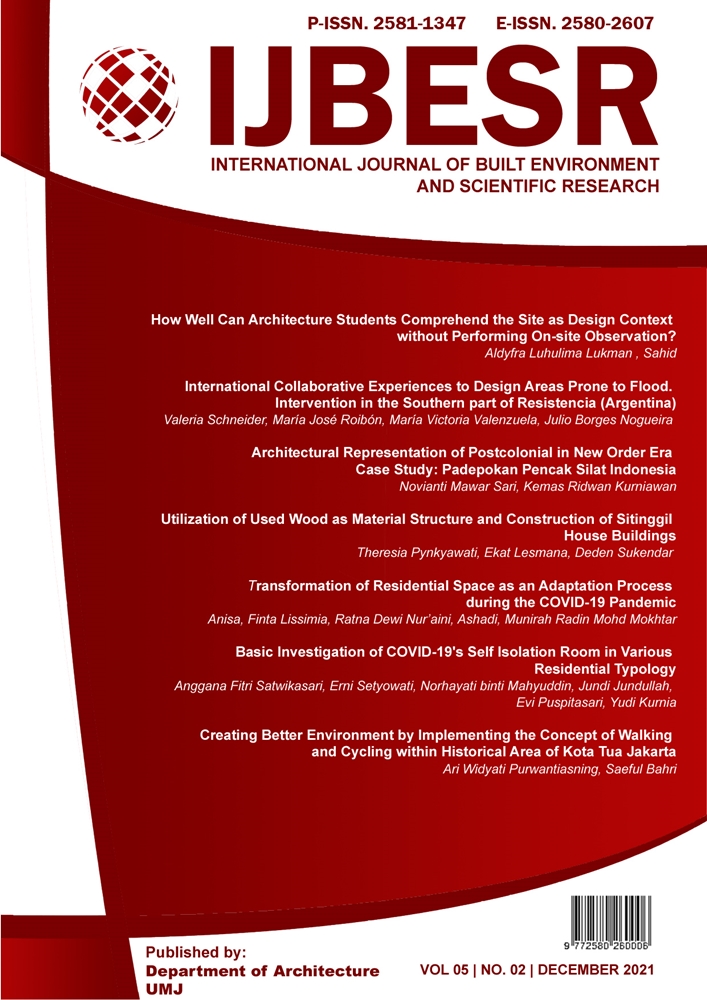Transformation of Residential Space as an Adaptation Process during the COVID-19 Pandemic
DOI:
https://doi.org/10.24853/ijbesr.5.2.109-120Keywords:
Transformation, Occupancy, Adaptation, Covid-19 PandemicAbstract
A residence is a place to live that accommodates daily activities. Under normal conditions, housing is used as a place to unwind after work and school outside the home. Since December 2019 major changes have taken place globally that have an impact on housing. This change was due to the rapid spread of the COVID-19 virus and reached various regions. Changes due to the spread of the Covid-19 virus have caused changes in the order of life because all activities that were initially carried out outside the home, have shifted to being carried out indoors. This happens because to reduce the impact of the spread of the virus, humans must practice social distancing. The biggest change that occurred was the shift from formal school activities and work to housing. With the addition of this activity, the residence must be able to be used functionally and meet comfort for the smooth running of activities in it. The purpose of this study is to identify, describe, and interpret changes in the function of space in residential areas as an adaptation process during a pandemic. The research method used is qualitative with purposive sampling. This qualitative research was conducted inductively by observing and interviewing the research case. Data were taken purposively on 6 residential areas in Jakarta, Depok, Bogor, Tangerang, and Bekasi. The results of this study are changes that occur in residential spaces in the form of non-physical changes, namely by adding activities that are accommodated in the space. Physically the space has not changed, this shows that the non-physical changes that occur are an adaptation process carried out by residential users. The adaptation process that occurs begins with adjusting activities to the available space in the dwelling. In the process of adaptation that occurs will choose a room that has the character as the need for new activities during the pandemic. In the end, housing can provide a positive response to the COVID-19 pandemic with flexibility in the use of space to accommodate new functions.References
Alexander, Christopher. 1987. A New Theory of Urban Design, Oxford University Press.
Astuti, Isti Yuli dan Harun. 2021. Tantangan Guru dan Orang Tua dalam Kegiatan Belajar dari Rumah Anak Usia Dini pada Masa Pandemi Covid-19. Jurnal Obsesi: Jurnal Pendidikan Anak Usia Dini, Volume 5 No. 2 (1441-1463)
Ayuni, D., Marini, T., Fauziddin, M, & Fahrul, Y. 2021. Kesiapan Guru TK Menghadapi Pembelajaran Daring Masa Pandemi Covid-19. Jurnal Obsesi: Jurnal Obsesi: Jurnal Pendidikan Anak Usia Dini, Volume 5 No. 1 (414-421)
Budihardjo, Eko. 1994. Percikan Masalah Arsitektur, Perumahan Perkotaan. Yogyakarta: Gadjah Mada University Press.
Pebriana, Putri Hana. 2017. Analisis Penggunaan Gadget terhadap Kemampuan Interaksi Sosial pada Anak Usia Dini. Jurnal Obsesi: Jurnal Pendidikan Anak Usia Dini, Volume 1 No. 1.
Rapoport, Amos. 1969. House, Form and Culture. Prentice Hall, Inc. London.
Simbolon, Agustina Sri Rezeki. 2020. Perubahan Fungsi Ruang Hunian Sederhana dengan Pendekatan Arsitektur Perilaku. Tesis Fakultas Teknik Universitas Sumatera Utara, Medan.
Susanti, I., Dewi, NIK., Permana, AY. 2018. Teritorial dalam Proses Perubahan Hunian. Jurnal Arsitektur Zonasi Volume 1 Nomor 1.
Yuliati. 2021. Peran Keluarga dalam Pencegahan Wabah Covid-19. Jurnal Pengabdian Masyarakat Volume 7 No.2
Sesotyaningtyas. 2015. Perubahan Hunian Dengan Perspektif Spasial Dan Tatanan Budaya: Komparasi Permukiman Kumuh Bang Bua, Thailand Dan Kampung Naga, Indonesia. Geoplanning Journal of Geocities and Planning Vol 2 No 2.
Maturana, Beatriz and Ashraf M. Salama. 2021. Architecture, urbanism and health in a post-pandemic virtual world. International Journal of Architectural Research Vol 15 No 1
Bettaieb, Donia M and Reem Alsabban. 2020. Emerging living styles post-COVID-19: housing flexibility as a fundamental requirement for apartments in Jeddah. International Journal of Architectural Research vol 15 No 1
Megahed, 2020. Indoor Air Quality: Rethinking rules of Building design Strategies in post pandemic Architecture. https://pubmed.ncbi.nlm.nih.gov/33197423/







